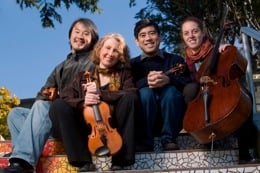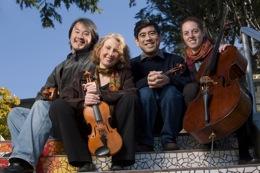
Presented at San Francisco’s Temple Emanu-el as the first concert of the Meyer series’ seventh season, the program featured Lou Harrison’s String Quartet Set, Gabriela Lena Frank’s Leyendas, Zhou Long’s Song of the Ch’in, and Béla Bartók’s String Quartet No. 3.
The four works covered a good deal of ground, inspired by cultures and locales as diverse as Zhou’s native China and the Peru of Frank’s ancestors. But in the solidly committed performances of the Del Sol musicians — violinists Kate Stenberg and Rick Shinozaki, violist Charlton Lee, and cellist Hannah Addario-Berry — each work yielded substantial rewards.
The program began and ended with music of the Americas, though Harrison’s 1979 String Quartet Set spends little time on the West Coast, where the composer was born, created many of his major works, and died (in 2003). Cast in five movements, this deliciously imaginative score — Harrison’s sole contribution to the string quartet repertoire — proceeds on a lark, making stops in medieval Europe, the French Baroque era, and an 18th-century Turkish court, with a rustic peasant’s dance and a solemn plaint serving as the connective tissue between homages to each era. Like all of Harrison’s music, the totality of the work is uniquely Lou: lovely and vivacious, brimming with zesty rhythms and captivating melodies. Del Sol’s performance of the French movement was so meltingly beautiful, it alone was worth the price of admission; but the quartet played the entire work with an abundance of charm.
Musical Effects From the High Andes
If Frank’s Leyendas, which ended the evening, suffered a bit in comparison, it wasn’t for lack of ambition. The Berkeley-based composer, whose mother is Peruvian-Chinese, explores various Peruvian musical traditions in this challenging 20-minute work. Composed in 2001 and subtitled An Andean Walkabout, the score is in six movements, which use a range of effects, including slides and trills, to suggest Peruvian panpipes, tarka (a wooden duct flute), charango (a high-pitched guitar), and quena (a bamboo flute.) To my ears, it didn’t quite cohere, though the Del Sol musicians gave it their all, attacking each movement with considerable brio. But errant tuning intermittently intruded, and Frank’s musical ideas often seemed swamped by her use of effects.Zhou’s Song of the Ch’in (1982) registered as a more successful integration of influence and expression. Adapting a folk song traditionally played on the ch’in, a seven-string Chinese zither, the composer employs techniques common to the instrument — plucked slides, fingernail flicks, pizzicato — in writing of enormous subtlety. In this brief but beautifully evocative work, the Del Sol’s performance emerged as the evening’s radiant centerpiece.
And then there was the Bartók! As Lee noted in his prefatory remarks, the Hungarian composer’s Quartet No. 3, written in 1926, was the “old music” on the program. No matter: This will always be one of the genuine revolutionaries in the quartet repertoire. Del Sol gave it a knockout performance, one that brought Bartók’s rustic dance melodies, heartbreaking night music, and harmonic brilliance to the fore with admirable nuance and intensity. In context with the other works on the program, it sounded folksy, decidedly modern, and downright forward-thinking — a model for composers throughout the 20th century and beyond.
The quartet returned to American music for its single encore, a shapely, exuberant performance of Astor Piazzolla’s Libertango.

